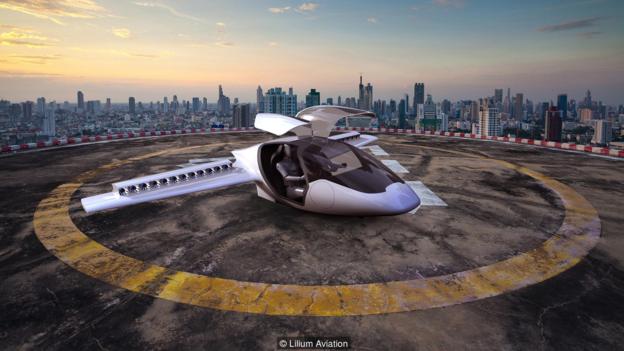A German startup called Lilium Aviation is working on a 100% electric short-haul private jet that may at last fulfill the promise of the flying car.
The company was founded in 2015 by a quartet of engineers and doctoral students from the Technical University of Munich and nurtured in a European Space Agency-funded business incubator. "Our goal is to develop an aircraft for use in everyday life,” says one of Lilium's founders, CEO Daniel Wiegand.
As the Lilium team sees it, the problem with personal aviation is airports, which are expensive to operate and utilise, and usually sit well away from city centres, negating their use as commuter hubs. "We are going for a plane that can take off and land vertically and does not need the complex and expensive infrastructure of an airport," says Wiegand.
The company's aircraft concept promises flight without the flight infrastructure. It will require an open space of just 225 square metres — about the size of a typical back garden — to take off and land. The Lilium Jet can cruise as far as 500km (310mi) at a very brisk 400kph (248mph), and reach an altitude of 3km (9,900ft). And it recharges overnight from a standard household outlet.
Yes, it is functionally similar to a helicopter, but the Lilium Jet presents some distinct advantages over traditional rotorcraft flying machines. For one, its battery powered ducted fans are significantly quieter — and cleaner — than the fuel-burning turbine and piston engines in helicopters. And, significantly, because the mid-flight failure of a helicopter's single engine could be catastrophic, they are expensive to engineer and build, and they require meticulous daily maintenance. The Lilium jet, however, uses 36 tiny ducted fan motors: 12 on each wing and 6 each in two swivelling nacelles that emerge from nose, producing a total of 435 horsepower. The propulsion system (including the electric fans, the 320kW battery pack and the power controllers) is designed for redundancy; the failure of one fan — or several — won't necessitate an emergency landing.
And, of course, helicopter-pilot training — which includes extensive schooling in safe-landing techniques after an engine failure — is exhaustive and expensive, consuming dozens of hours and costing upwards of £30,000. The Lilium jet, in contrast, will be classified as a Light Sport Aircraft for two occupants, for which licensing requires a scant 20 to 30 hours of training and usually runs less than £6,000. The trickiest part of flying a Lilium — those vertical take-offs and landings — will be handled by an autonomous control system, similar to the planned EHang 184 four-rotor personal drone and the Terrafugia TF-X.
Naturally, such accessibility has a few trade-offs. The Lilium Jet's LSA classification limits its operation to uncongested airspace during daytime hours, and only in fair weather. And even with the aircraft's promise of quiet, emissions-free operation, it may be a while before aviation authorities allow vertical take-offs and landings — even computer-guided ones — from the Joneses' back garden. And unlike such road-ready vehicles as the Terrafugia, the Dutch-made PAL-V One and the Aeromobil from Slovakia, the wheel-less Lilium Jet is strictly a flying machine.
And yet, compared with the wildly complex Terrafugia, the Lilium Jet is a remarkably simple machine, and it is that simplicity that has put it on the fast track toward series production. The company has successfully demonstrated the concept with a 25-kilogram flying prototype, and is presently crafting a full-size version. Lilium plans to have a production model ready by the stroke of midnight on 31 Dec 2018.
The future is coming soon, but you still have time to install a windsock atop the garage.
(BBC)






www.ann.az
Follow us !











